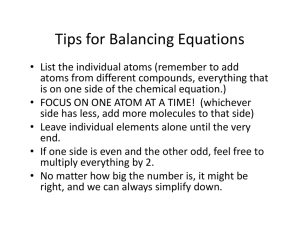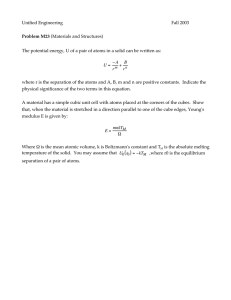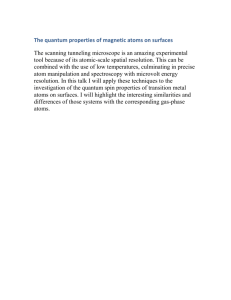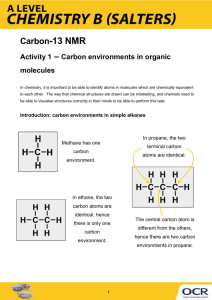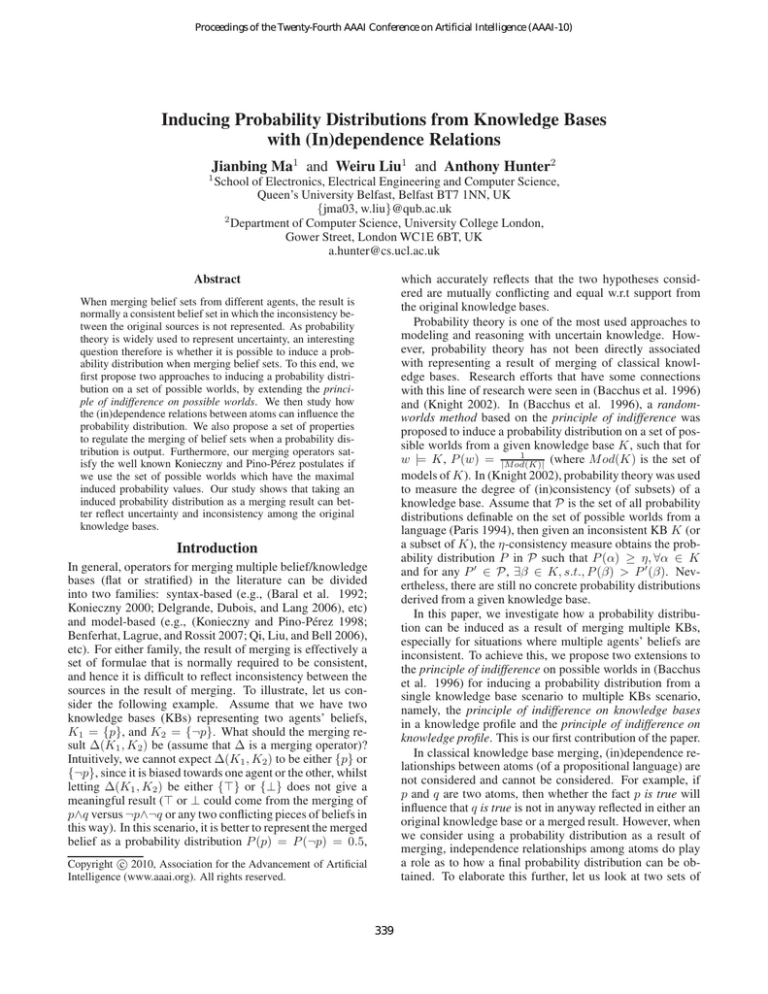
Proceedings of the Twenty-Fourth AAAI Conference on Artificial Intelligence (AAAI-10)
Inducing Probability Distributions from Knowledge Bases
with (In)dependence Relations
Jianbing Ma1 and Weiru Liu1 and Anthony Hunter2
1
School of Electronics, Electrical Engineering and Computer Science,
Queen’s University Belfast, Belfast BT7 1NN, UK
{jma03, w.liu}@qub.ac.uk
2
Department of Computer Science, University College London,
Gower Street, London WC1E 6BT, UK
a.hunter@cs.ucl.ac.uk
which accurately reflects that the two hypotheses considered are mutually conflicting and equal w.r.t support from
the original knowledge bases.
Probability theory is one of the most used approaches to
modeling and reasoning with uncertain knowledge. However, probability theory has not been directly associated
with representing a result of merging of classical knowledge bases. Research efforts that have some connections
with this line of research were seen in (Bacchus et al. 1996)
and (Knight 2002). In (Bacchus et al. 1996), a randomworlds method based on the principle of indifference was
proposed to induce a probability distribution on a set of possible worlds from a given knowledge base K, such that for
1
w |= K, P (w) = |Mod(K)|
(where M od(K) is the set of
models of K). In (Knight 2002), probability theory was used
to measure the degree of (in)consistency (of subsets) of a
knowledge base. Assume that P is the set of all probability
distributions definable on the set of possible worlds from a
language (Paris 1994), then given an inconsistent KB K (or
a subset of K), the η-consistency measure obtains the probability distribution P in P such that P (α) ≥ η, ∀α ∈ K
and for any P ′ ∈ P, ∃β ∈ K, s.t., P (β) > P ′ (β). Nevertheless, there are still no concrete probability distributions
derived from a given knowledge base.
In this paper, we investigate how a probability distribution can be induced as a result of merging multiple KBs,
especially for situations where multiple agents’ beliefs are
inconsistent. To achieve this, we propose two extensions to
the principle of indifference on possible worlds in (Bacchus
et al. 1996) for inducing a probability distribution from a
single knowledge base scenario to multiple KBs scenario,
namely, the principle of indifference on knowledge bases
in a knowledge profile and the principle of indifference on
knowledge profile. This is our first contribution of the paper.
In classical knowledge base merging, (in)dependence relationships between atoms (of a propositional language) are
not considered and cannot be considered. For example, if
p and q are two atoms, then whether the fact p is true will
influence that q is true is not in anyway reflected in either an
original knowledge base or a merged result. However, when
we consider using a probability distribution as a result of
merging, independence relationships among atoms do play
a role as to how a final probability distribution can be obtained. To elaborate this further, let us look at two sets of
Abstract
When merging belief sets from different agents, the result is
normally a consistent belief set in which the inconsistency between the original sources is not represented. As probability
theory is widely used to represent uncertainty, an interesting
question therefore is whether it is possible to induce a probability distribution when merging belief sets. To this end, we
first propose two approaches to inducing a probability distribution on a set of possible worlds, by extending the principle of indifference on possible worlds. We then study how
the (in)dependence relations between atoms can influence the
probability distribution. We also propose a set of properties
to regulate the merging of belief sets when a probability distribution is output. Furthermore, our merging operators satisfy the well known Konieczny and Pino-Pérez postulates if
we use the set of possible worlds which have the maximal
induced probability values. Our study shows that taking an
induced probability distribution as a merging result can better reflect uncertainty and inconsistency among the original
knowledge bases.
Introduction
In general, operators for merging multiple belief/knowledge
bases (flat or stratified) in the literature can be divided
into two families: syntax-based (e.g., (Baral et al. 1992;
Konieczny 2000; Delgrande, Dubois, and Lang 2006), etc)
and model-based (e.g., (Konieczny and Pino-Pérez 1998;
Benferhat, Lagrue, and Rossit 2007; Qi, Liu, and Bell 2006),
etc). For either family, the result of merging is effectively a
set of formulae that is normally required to be consistent,
and hence it is difficult to reflect inconsistency between the
sources in the result of merging. To illustrate, let us consider the following example. Assume that we have two
knowledge bases (KBs) representing two agents’ beliefs,
K1 = {p}, and K2 = {¬p}. What should the merging result ∆(K1 , K2 ) be (assume that ∆ is a merging operator)?
Intuitively, we cannot expect ∆(K1 , K2 ) to be either {p} or
{¬p}, since it is biased towards one agent or the other, whilst
letting ∆(K1 , K2 ) be either {⊤} or {⊥} does not give a
meaningful result (⊤ or ⊥ could come from the merging of
p∧q versus ¬p∧¬q or any two conflicting pieces of beliefs in
this way). In this scenario, it is better to represent the merged
belief as a probability distribution P (p) = P (¬p) = 0.5,
c 2010, Association for the Advancement of Artificial
Copyright Intelligence (www.aaai.org). All rights reserved.
339
Preliminaries
knowledge bases in the following example.
Example 1 Assume that three people are discussing a person holding a flag spotted at a distance. The three knowledge bases obtained from them are K1 = {¬m}, K2 =
{r∧m} and K3 = {r}, where m for the person is a male and
r for the flag is red. An intuitive conclusion is that the flag
is red but we do not know whether the person is a male. An
underlying assumption for drawing this conclusion in commonsense reasoning is that the color of a flag and the gender
of a person are largely independent. Hence the contradicting opinions on the gender of the person do not affect the
consistent opinions about the color of the flag.
Now, let us reword this example as follows. Assume that
three people are discussing a person’s salary and his profession. The three knowledge bases obtained from them are
K1 = {¬m}, K2 = {r ∧ m} and K3 = {r}, where m for
the person is a professor and r for the salary is over $80k.
What would be the result of merging?
We consider a propositional language LP defined from a
finite set P of propositional atoms, denoted by p, q, r etc
(possibly with superscripts). An interpretation w (or possible world) is a function that maps P onto the set {0, 1}. The
set of all interpretations is denoted as W . w is a model of
(or satisfies) φ iff w(φ) = 1, denoted as w |= φ. We denote M od(φ) as the set of models for φ. A term on a set of
atoms {p1 , · · · , pk } is a formula with the form p′1 ∧ · · · ∧ p′k
in which literal p′i is either pi or ¬pi , 1 ≤ i ≤ k.
A (flat) knowledge base K is a finite set of propositions.
K is consistent iff there is at least one interpretation that
satisfies all propositions in K.
A knowledge profile E is a multi-set
bases
F of knowledge
F F
such that E = {K1 , K2 , · · · , Kn }. V
E = K1 ... Kn
denotes the multi-set union of Ki s and E = K1 ∧ ... ∧ Kn
denotes the conjunction
V of knowledge bases Ki s of E. E is
called consistent iff E is consistent. Let E denote all the
atoms appeared in E. E1 ↔ E2 denotes that there is a bijection g from E1 = {K11 , · · · , Kn1 } to E2 = {K12 , · · · , Kn2 }
such that ⊢ g(K) ↔ K.
In this example, conclusion {r} seems largely acceptable
for the first scenario because we usually disassociate the attribute color of a flag from the attribute gender of a person. On the other hand, conclusion {r} seems much less
acceptable in the 2nd scenario because we know a person’s
profession and his salary are closely related. A merging operator for classical KBs, such as, ∆dD ,sum,sum (Konieczny,
Lang, and Marquis 2004), ∆dH , (Revesz 1997), produces
the same solution {r} for both sets of KBs (scenarios) regardless of if there are any dependencies among atoms (attributes).
Therefore, independence relationships between atoms
must be considered, since such independence relationships
influence how a probability distribution is defined. To
achieve this, we develop two approaches to revising induced probability distributions from the two extensions,
with (in)dependence relationships between atoms considered. This is our second main contribution of the paper.
An induced probability distribution from a set of knowledge bases should truly reflect the beliefs encoded by these
bases. We propose the following three constraints on an induced probability distribution. This is our third contribution.
Inducing Probability Distributions
In (Bacchus et al. 1996), a random-worlds method was proposed to induce a probability distribution on a set of possible
worlds from a single knowledge base. This method is based
on the principle of indifference to possible worlds which
states that given a knowledge base K, all the models of the
knowledge base are equally likely. That is, ∀w ∈ M od(K),
1
(otherwise P (w) = 0) where P is a probP (w) = |Mod(K)|
ability distribution on W . This method cannot be directly
applied to induce a probability distribution from a knowledge profile, since the existence of multiple KBs may need
to be taken into account. In this section, we propose two
extensions to this principle in order to induce a probability
distribution from a knowledge profile.
Before proceeding with these extensions, let us first formalize the following three constraints that shall be satisfied
by an induced probability distribution, as we discussed in
the Introduction. Let E be a knowledge profile and PE be
an induced probability distribution from E.
• A possible world considered possible by some agents
should receive a positive probability value, otherwise its
probability value is 0. This is the Positiveness principle.
w-Positiveness: If ∀Ki ∈ E, w 6|= Ki , then PE (w) = 0;
else PE (w) > 0.
w-Positiveness states that if a possible world w is considered impossible by all agents, then its induced probability
value should be 0; otherwise this value is positive.
• A possible world considered at least as possible as another
possible world by all agents shall be assigned with a probability value at least as large as the value assigned to the
latter one. This is the Monotonicity principle.
w-Monotonicity: For any Ki ∈ E, if w1 |= Ki implies
w2 |= Ki , then PE (w2 ) ≥ PE (w1 ). In addition, if
∃Kj ∈ E such that w2 |= Kj but w1 6|= Kj , then
PE (w2 ) > PE (w1 ).
w-Monotonicity says that if w2 is believed at least as plausible as w1 , then the induced probability value for w2
should not be less than that assigned to w1 .
• Probability values on possible worlds should be insensitive to syntax. This is the Syntax-irrelevance principle.
The rest of the paper is organized as follows. Section 2 introduces preliminaries. In Section 3, we propose two methods for inducing probability distributions. In Section 4, we
propose approaches to revising an induced probability distribution considering where some atoms are (in)dependent.
In Section 5, we compare our merging framework with logic
based merging. Finally, we conclude the paper in Section 6.
Syntax-Irrelevance: Let α, β be two formulae, then for
any w, PE∪{{α∧β}} (w) = PE∪{{α,β}} (w). If α′ is a formula such that α ≡ α′ , then for any w, PE∪{{α}} (w) =
PE∪{{α′ }} (w).
340
Syntax irrelevance property is a reasonable property in
many logic based reasoning systems, such as, knowledge
bases merging (Konieczny and Pino-Pérez 1998).
Definition 2 (Principle of Indifference to Knowledge Profile) Based on this principle, a probability distribution
PEIndE over W is defined s.t. for w ∈ W
1 X w(K)
.
|E| i=1 |M od(Ki )|
|E|
Principle of indifference to knowledge bases
PEIndE (w) =
The first extension we attempt to achieve is that for any w, if
it is considered possible by a subset of knowledge bases in
the profile, then each K in the subset provides an equally
likely probability value for w, regardless of which K it
is. The final probability value for w is proportional to the
sum of such equally likely probability values supporting it.
This extension is referred to the principle of indifference to
knowledge bases. That is, all knowledge bases are treated
equally w.r.t. a possible world that is their common model.
In another words, each of them contributes the same amount
of probability to a possible world that is a model of them.
Let ▽ be an operator mapping knowledge profiles to probability distributions and E be a knowledge profile.
Definition 1 (Principle of Indifference to Knowledge bases)
Based on this principle, ▽(E) produces a probability distribution PEIndK over W s.t., for w ∈ W
S(w)
PEIndK (w) = P
(1)
′
′
w ∈W S(w )
(2)
Note that w(K) = 1 if w |= K and 0 otherwise (definition
of a possible world). Also, Equation 2 requires each K considered is consistent whilst Definition
P1 does not require this.
In addition, it is easy to check that w∈W PEIndE (w) = 1.
Proposition 2 PEIndE
satisfies w-Positiveness,
Monotonicity, and Syntax-Irrelevance.
w-
Example 3 (Example 1 Cont.) Let E = {K1 , K2 , K3 }
such that K1 = {¬m}, K2 = {r ∧ m} and K3 = {r}, then
from Def. 2, we get PEIndE (¬m ∧ r) = 13 , PEIndE (¬m ∧
¬r) = 16 , PEIndE (m ∧ r) = 12 , and PEIndE (m ∧ ¬r) = 0.
With the different points of view captured by the two principles of indifference, the merging result from either Example 2 or Example 3 can be considered acceptable. For
instance, with the second extension (Example 3), we have
K1 strongly rejects m ∧ r, K2 strongly supports it, whilst
K3 partially supports it, therefore it is reasonable to obtain
PEIndE (m ∧ r) = 12 . Therefore, which approach among the
two to use largely depends on the application scenario.
where S(w) = |{Ki s.t. Ki ∈ E, w |= Ki }|.
S(w)Pis the number of KBs which consider
w possible,
P
and w′ ∈W S(w′ ) can be rewritten as Ki ∈E |M od(Ki )|.
P
Obviously, we have w∈W PEIndK (w) = 1 which shows
PEIndK is a valid probability distribution.
For convenience, hereafter, we omit notation ▽(E) and
simply use a probability distribution as a result of merging.
Proposition 1 PEIndK
satisfies w-Positiveness,
wMonotonicity, and Syntax-Irrelevance.
Example 2 (Example 1 Cont.) Let E = {K1 , K2 , K3 }
such that K1 = {¬m}, K2 = {r ∧ m} and K3 = {r}, then
from Def. 1, we get PEIndK (¬m ∧ r) = PEIndK (m ∧ r) =
2
IndK
(¬m ∧ ¬r) = 15 , PEIndK (m ∧ ¬r) = 0.
5 , PE
In this example, five possible worlds are models of these
KBs (i.e., K1 has two models, K2 has one and K3 has two).
Possible world m ∧ r has 1/5 support from K2 and K3 respectively. Therefore, it has a probability value 2/5.
The fact that K1 has more models than K2 is not fully
considered under this principle. It may be useful to take
such a fact into account, especially when a KB K has a large
number of models (so K is less specific than other KBs).
This leads us to the second extension below.
Effect of relationship between atoms
When we induce a probability distribution on a set of possible worlds as the result of merging, we have not yet consider
if any atoms defining the language are dependent in terms of
probability theory. This is consistent with what has been
done in logic-based merging, where relationships between
atoms are not considered. However, when we consider probability distributions emerging from a knowledge profile, we
must investigate how relationships among atoms will affect
an induced probability distribution.
Let us first recall the definition of independence relationship in probability theory.
Definition 3 Let {p1 , · · · , pn } be the set of atoms and P a
probability measure on {p1 , · · · , pn }. p1 , · · · , pn are mutually independent w.r.t. P iff for any subset {pi1 , · · · , pik } of
Qk
{p1 , · · · , pn }, we have P (pi1 ∧ · · · ∧ pik ) = j=1 P (pij ).
The necessity of considering (in)dependence
relationships: an example
Example 4 (Example 1 Cont.) Recall that the conclusion
we draw from the first scenario in this example is that the
flag is red but we do not know whether the person is a male
or not. In terms of probability theory, we expect a probability distribution P that is compatible with this conclusion
would generate P (m) = P (¬m) = 21 (impartial about the
person being a male or a female), P (r) > P (¬r) (the flag
is more likely to be red), and P (m∧r) = P (¬m∧r) (otherwise we may infer it is a male holding a red flag or a female
holding a red flag).
In Example 2, we have PEIndK (¬m ∧ r) = PEIndK (¬m ∧
¬r) = 52 , PEIndK (m ∧ r) = 15 . Therefore, we get
Principle of indifference to knowledge profile
The second extension we aim to achieve is that for a given
1
K, the contribution from K to w is |Mod(K)|
if w ∈
M od(K) or 0 otherwise. Then for each w, its probability
contributions from all the KBs are accumulated, and finally
this accumulated value is normalized by the total number of
KBs that a profile has. In another word, it is the whole profile (not just the KBs that have contributed to w) determines
the final outcome. This extension, is referred to as the principle of indifference to knowledge profile.
341
PEIndK (m) = 51 , PEIndK (¬m) = 45 , and PEIndK (r) =
3
IndK
(¬r) = 25 . This result is different from our in5 , PE
tuitive conclusion and tempts us to believe that the person
may not be a male, since PEIndK (m) < PEIndK (¬m).
In Example 3, we have PEIndE (¬m ∧ r)
=
1
1
1
IndE
IndE
,
P
(¬m
∧
¬r)
=
,
P
(m
∧
r)
=
.
Since
m
∧
r
E
E
3
6
2
has the largest probability value, it may lead us to believe
that it is a male holding a red flag which is also inconsistent
with our intuition.
Definition 4 (Support for p) Let E be a knowledge profile
and p be an atom, then the support for p w.r.t E is defined
P|E|
as SuppE (p) =
i=1 |SuppKi (p)| where SuppKi (p) =
{w, s.t., w |= p, w |= Ki }.
SuppKi (p) means that we count the number of possible
worlds that are models of p and are also models of a knowledge base Ki . That is, p and Ki are consistent since they
have at least one common model w, and hence knowledge
base Ki can be considered as at least partially supporting p
w.r.t w. Then the support for p from the whole profile E is
the sum of its support from each Ki .
Based on the definition of support for p, a probability
value on p can be calculated as follows.
The main reason for not being able to draw a satisfactory
result from the two induced probability distributions is that
the independence assumption between m (a male) and r (a
red flag) was not considered. In fact, from the intuitions that
P (m) = P (¬m) = 12 , P (r) > P (¬r), and P (m ∧ r) =
P (¬m∧r), we can infer that P (r|m) = P (r ∧m)/P (m) =
2P (r ∧ m) = P (r ∧ m) + P (r ∧ ¬m) = P (r). That is, r
and m are probabilistically independent. This kind of independence relationship among atoms, which cannot be represented in a logic-based representation of knowledge bases,
exists in common sense reasoning and real-world applications. Therefore, when considering probability distributions
induced from knowledge base merging, such independence
relationships must be considered.
P|E|
Obviously, SuppE (p) + SuppE (¬p) = i=1 |M od(Ki )|,
supp
supp
and we have ∀p, PE (p) + PE (¬p) = 1 which shows
that PEsupp is a valid probability distribution.
All atoms are pair-wise independent
Proposition 3 PEsupp
satisfies
a-Positiveness,
Monotonicity, and Syntax-Irrelevance.
Definition 5 (Probability value on atom through its support) Let E be a knowledge profile and p be an atom, then a
probability value generated from E for p is defined as
PEsupp (p) =
In this subsection, we consider situations where all atoms
are pair-wise independent. We start with defining probabilities on atoms, since if all atoms are probabilistically independent, a unique probability distribution on possible worlds
(w.r.t Def. 3) can be obtained, and hence probability on formulae can be calculated from their models. It should be
pointed out that the following two definitions on induced
probability functions on atoms are counterparts of the ones
defined in Definitions 1 and 2, respectively. Probability
values on atoms derived from a knowledge profile should
also satisfy certain constraints. By extending the above constraints on a probability distribution on possible worlds, we
have the following revised constraints (Syntax-Irrelevance
does not need to be changed).
|SuppE (p)|
.
|SuppE (p) + SuppE (¬p)|
(3)
a-
Example 5 (Example 1 Cont.) Let E = {K1 , K2 , K3 }
such that K1 = {¬m}, K2 = {r ∧ m} and K3 = {r},
then from Def. 5, we get PEsupp (m) = 52 , PEsupp (r) = 54 .
Observe that PEsupp (m) = PEIndK (m), PEsupp (r) =
PEIndK (r). This fact holds in general as stated by the following proposition.
Proposition 4 Let E be a knowledge profile, then for
any p ∈
, we have PEsupp (p) = PEIndK (p), where
E
P
IndK
PE
(p) = w|=p PEIndK (w).
PEsupp is in fact a counterpart of PEIndK on atoms
where relationships between atoms are considered. However, for a propositional formula µ, generally we do not
have PEsupp (µ) = PEIndK (µ) due to the existence of
(in)dependence relations.
a-Positiveness If ∀Ki ∈ E, Ki |= p, then PE (p) = 1; if
∀Ki ∈ E, Ki |= ¬p, then PE (p) = 0; else PE (p) ∈
(0, 1).
a-Positiveness (atom-Positiveness) states that if all agents
believe that p is true, then the merging result should also
believe that p is true. Conversely, it all agents think p
is false, then the merging result also considers it false.
Otherwise p is not totally believed or disbelieved.
Definition 6 (Probability value on atom through its ratio of
support) Let E be a knowledge profile, and p be an atom,
then a probability value generated from E for p is defined as
1 X
|SuppKi (p)|
.
|E| i=1 |SuppKi (p)| + |SuppKi (¬p)|
|E|
PEr (p) =
a-Monotonicity For any Ki ∈ E, if Ki |= p1 implies
Ki |= p2 , then PE (p2 ) ≥ PE (p1 ). Furthermore, if
∃Kj ∈ E such that Kj |= p2 but Kj 6|= p1 , then
PE (p2 ) > PE (p1 ).
a-Monotonicity says that if p2 is believed at least to the
degree of p1 , then the induced probability value for p2
should not be less than that assigned to p1 .
(4)
It is easy to verify that ∀p, PEr (p) + PEr (¬p) = 1, hence PEr
is indeed a valid probability function.
Proposition 5 PEr satisfies a-Positiveness, a-Monotonicity,
and Syntax-Irrelevance.
Below we show that PEr is indeed a counterpart of PEIndE .
Proposition 6 Let E be a knowledge profile, then for any
p ∈ E , we have PEIndE (p) = PEr (p).
Below, we provide two counterparts of Def. 1 and Def. 2
on atoms.
342
Example 6 (Example 1 Cont.) Let E = {K1 , K2 , K3 }
such that K1 = {¬m}, K2 = {r ∧ m} and K3 = {r},
then from Def. 6, we get PEr (m) = 12 , PEr (r) = 56 . Obviously this result is more consistent with our intuition such
that PEr (m) = PEr (¬m) = 21 , PEr (r) > PEr (¬r), and
PEr (m ∧ r) = PEr (¬m ∧ r).
which gives a partition of atoms as L = {{p, q}, {r}}. Then
we have S 1 = {p∧q, p∧¬q, ¬p∧q, ¬p∧¬q}, S 2 = {r, ¬r}
and
supp
supp
PE dep (p ∧ q) = 1/3, PE dep (p ∧ ¬q) = 1/9,
suppdep
Results from Examples 5 and 6 illustrate that in some scenarios, the principle of indifference to knowledge profile is
more reasonable than that to knowledge bases.
Some atoms are independent
Now we investigate situations where some atoms are independent, contrary to what is assumed in the above subsection. This assumption is rational in many real-world applications. Typically when atoms (attributes) are defined, their
(in)dependent relationships are clear from context1 .
To proceed, here we assume that the dependence relation
between atoms is an equivalence relation which satisfies the
following conditions.
supp
This proposition shows that PE dep is actually a counterpart of PEsupp and hence of PEIndK .
Propositions 4 and 7 together reveal that no matter how
atoms are related (dependent or independent), the support to
them by the original knowledge bases in a profile is solely
determined by these KBs. Therefore, all these apparently
different probability functions produce the same probability
values on atoms, but with different probability values on formulae giving different (in)dependence assumptions. This is
not surprising, because (in)dependence relations only influence the calculation of probability values on formulae (and
possible worlds) but not on atoms.
Now we consider the counterpart of PEr .
Definition 8 (A counterpart of PEr ) Let E be a knowledge
profile and s ∈ S j be a term generated as above. Then the
probability value of s is calculated by
• ∀p, p is dependent of p,
• ∀p, q, p is dependent of q iff q is dependent of p,
• ∀p, q, r, if p is dependent of q and q is dependent of r,
then p is dependent of r.
With these conditions, E = {p1 , · · · , pn } can be partitioned by a dependence relation. Let a partition of E
be L = {{p11 , · · · , p0m1 }, · · · , {pk1 , · · · , pkmk }} s.t. for any
p, p′ ∈ E if ∃L ∈ L where p, p′ ∈ L then p and p′ are
dependent, otherwise they are independent. Two extremes
are either all the atoms are dependent (so there is only one
subset in the partition) or all the atoms are independent (then
we have exactly n partition groups).
For a subset L = {pi1 , · · · , pimi }, let S i be the set of terms
generated from {pi1 , · · · , pimi }, and s ∈ S i be an arbitrary
term, then a probability value for s is defined as follows.
suppdep
(s) = P
SuppE (s)
.
s∈S i SuppE (s)
SuppKi (s)
1 X
P
.
|E| i=1 s∈S j SuppKi (s)
|E|
r
PEdep (s) =
(6)
where SuppKi (s) is defined similarly to SuppKi (p) in Def
4 when replacing p with s.
P
r
r
Similarly, for PEdep , we have ∀S i , s∈S i PEdep (s) = 1.
Example 8 Let E = {K1 , K2 , K3 } such that K1 = {(p ∨
q) ∧ r}, K2 = {¬p ∧ ¬r} and K3 = {q}, and we have p, q
are dependent, and r is independent of p and q, then we have
r
r
PEdep (p ∧ q) = 5/18, PEdep (p ∧ ¬q) = 1/9,
Definition 7 (A counterpart of PEsupp ) Let E be a knowledge profile and s ∈ S i be a term generated as above. Then
the probability value of s is calculated by
PE
supp
(¬p ∧ q) = 4/9, PE dep (¬p ∧ ¬q) = 1/9,
suppdep
supp
PE
(r) = 5/9, PE dep (¬r) = 4/9.
Now we can calculate probability values on possible
worlds and also on formulae. For instance, we have
supp
supp
PE dep (p ∧ q ∧ r) = 5/27 and PE dep (p ∧ r) = 20/81.
Proposition 7 Let E be a knowledge profile, then for any
supp
p ∈ E , we have PEsupp (p) = PE dep (p).
PE
(5)
r
r
PEdep (¬p ∧ q) = 4/9, PEdep (¬p ∧ ¬q) = 1/6,
r
r
PEdep (r) = 1/2, PEdep (¬r) = 1/2.
We also have the following result.
Proposition 8 Let E be a knowledge profile, then for any
r
p ∈ E , we have PEr (p) = PEdep (p).
′
A possible world w = p1 ∧ · · · ∧ p′n (where p′i is pi or
¬pi ) can be rewritten as w = s1 ∧ · · · ∧ sk (where each
si is a term from subset Li of a partition). Since atoms
in different subsets of a partition are mutually independent,
Qk
r
r
supp
we have PEdep (w) = i=1 PEdep (si ) (or PE dep (w) =
Qk
suppdep
(si )).
i=1 PE
Definitions 7 and 8 together can be regarded as a general
framework subsuming Definitions 1 and 2 respectively when
no independence relationships are observed, and Definitions
5 and 6 respectively when all the atoms are independent.
Formally, we have the following two propositions.
where SuppE (s) is defined similarly to SuppE (p) in Def 4
when replacing p with s.
supp
The
soundness of PE dep is verified by ∀S i ,
P
suppdep
(s) = 1. Since a possible world w
s∈S i PE
Vk
can be written as w = i=1 si where si ∈ S i is a term and
k is the number of partitions (partitioned by dependence
relations) described above, and si is independent of sj for
Qk
supp
supp
i=
6 j, we have PE dep (w) = i=1 PE dep (si ).
Example 7 Let E = {K1 , K2 , K3 } such that K1 = {(p ∨
q)∧r}, K2 = {¬p∧¬r} and K3 = {q}. We further assume
that p, q are dependent, and r is independent of p and q,
1
Determining whether atoms are (in)dependent can be a complex task which is beyond the scope of this paper. Here we assume
that (in)dependence relations among atoms concerned are given.
343
Proposition 9 Given a knowledge profile E, if no indepensupp
dence relationships on atoms are given, then PE dep (Eq.
IndK
5) is reduced to PE
(Eq. 1); if all atoms are pair-wise
supp
independent, then PE dep is reduced to PEsupp (Eq. 3).
Due to space limitation, we omit the comparison between
∆IndK (E) and ∆IndE (E) with the Majority and the Arbitrary postulates in (Konieczny and Pino-Pérez 1998). We
can conclude that both ∆IndK (E) and ∆IndE (E) are neither majority operators nor arbitrary operators.
Proposition 10 Given a knowledge profile E, if no indepenr
dence relations are specified, then PEdep (Eq. 6) is reduced
to PEIndE (Eq. 2); if all atoms are assumed pair-wise inder
pendent, then PEdep is reduced to PEr (Eq. 4).
Conclusion
In this paper, we have investigated how probability distributions can be obtained when merging multiple knowledge
bases. A key motivation for obtaining a probability distribution rather than a flat knowledge base is to better preserve
inconsistent knowledge from the original KBs. We have proposed two definitions to define an induced probability distribution based on two extensions to the principle of indifference to possible worlds proposed in (Bacchus et al. 1996).
These two definitions were then revised for situations
where all atoms are independent or some atoms are dependent, since independence relations between atoms can significant affect induced probability distributions. Comparison with logic based merging postulates shows that our
merging framework is consistent with logic based merging when no information about (in)dependent relationships
among atoms is available.
One possibility for future work is to investigate if other
approaches to inducing probability distributions can be developed when the requirement on principle of indifference
on possible worlds (resp. KBs, or profile) is removed.
Acknowledge: This research is supported by the UK EPSRC projects EP/D070864/1 and EP/D074282/1.
From Propositions 9 and 10, and the fact that PEIndK and
PEIndE follow the principles of indifference on knowledge
supp
bases and on profile, respectively, we can say that PE dep
r
(resp. PEsupp ) and PEdep (resp. PEr ) also follow the principles of indifference on knowledge bases and on profile,
respectively, except that the principles are focused on terms
(resp. atoms) instead of on possible worlds. Therefore, the
principle of indifference is the foundation for defining all the
probability distributions.
Related Work
In (Konieczny and Pino-Pérez 1998), an merging operator
∆ is a mapping from knowledge profiles to knowledge bases
satisfying the following set of postulates:
A1 ∆(E) is consistent.
A2 If E is consistent, then ∆(E) =
V
E.
A3 If E1 ↔ E2 , then ⊢ ∆(E1 ) ↔ ∆(E2 ).
A4 If K ∧ K ′ is not consistent, then ∆(K
F
A5 ∆(E1 ) ∧ ∆(E2 ) ⊢ ∆(E1 E2 ).
F
K ′ ) 6⊢ K.
A6 If ∆(E1 ) ∧ ∆(E2 ) is consistent, then ∆(E1
∆(E1 ) ∧ ∆(E2 ).
F
References
Bacchus, F.; Grove, A.; Halpern, J.; and Koller, D. 1996. From statistical knowledge bases to degrees of belief. Artificial Intelligence
87(1-2):75–143.
Baral, C.; Kraus, S.; Minker, J.; and Subrahmanian, V. 1992. Combining knowledge bases consisting of first-order theories. Computational Intelligence 8(1):45–71.
Benferhat, S.; Lagrue, S.; and Rossit, J. 2007. An egalitarist fusion
of incommensurable ranked belief bases under constraints. In Proc.
of AAAI’07, 367–372.
Delgrande, J.; Dubois, D.; and Lang, J. 2006. Iterated revision as
prioritized merging. In Proc. of KR’06, 210–220.
Knight, K. 2002. Measuing inconsistency. Journal of Philosophical Logic 31(1):77–98.
Konieczny, S., and Pino-Pérez, R. 1998. On the logic of merging.
In Procs. of KR’98, 488–498.
Konieczny, S.; Lang, J.; and Marquis, P. 2004. Da2 merging operators. Artif. Intel. 157:49–79.
Konieczny, S. 2000. On the difference between merging knowledge bases and combining them. In Proc. of KR’00, 12–17.
Paris, J. 1994. The Uncertain Reasoner’s Companion. Cambridge
Univ. Press.
Qi, G.; Liu, W.; and Bell, D. A. 2006. Merging stratified knowledge bases under constraints. In Proc. of AAAI’06, 281–286.
Revesz, P. 1997. On the semantics of arbitration. Internat. J.
Algebra Comput. 7(2):133–160.
E2 ) ⊢
In our framework, an operator is a mapping from knowledge
profiles to probability distributions. Therefore, it is nature
to consider which postulates given above may be applicable to the operators in our merging framework. Since independence relationships are not considered in (Konieczny
and Pino-Pérez 1998), here we only consider operators producing PEIndK and PEIndE as merging results. To facilitate
the comparisons, we first define the set of most plausible
possible worlds generated based on either the total pre-order
PEIndK on W or PEIndE on W . To this, we use max(W, ≤)
to denote the set {w ∈ W |∄w′ ∈ W, w′ ≥ w} where ≤ is a
total-preorder, and f orm({w1 , · · · , wk }) to denote a propositional formula whose models are w1 , · · · , wk .
Definition 9 Let E be a knowledge profile, then the sets of
most plausible possible worlds from operator ∆IndK based
on PEIndK and operator ∆IndE from PEIndE are defined respectively as
∆IndK (E) = f orm(max(W, ≤PEIndK )) and
∆IndE (E) = f orm(max(W, ≤PEIndE )).
Then, we have the following result.
Proposition 11 Operator ∆IndK satisfies A1-A6, and operator ∆IndE satisfies A1-A3,A5,A6.
344

